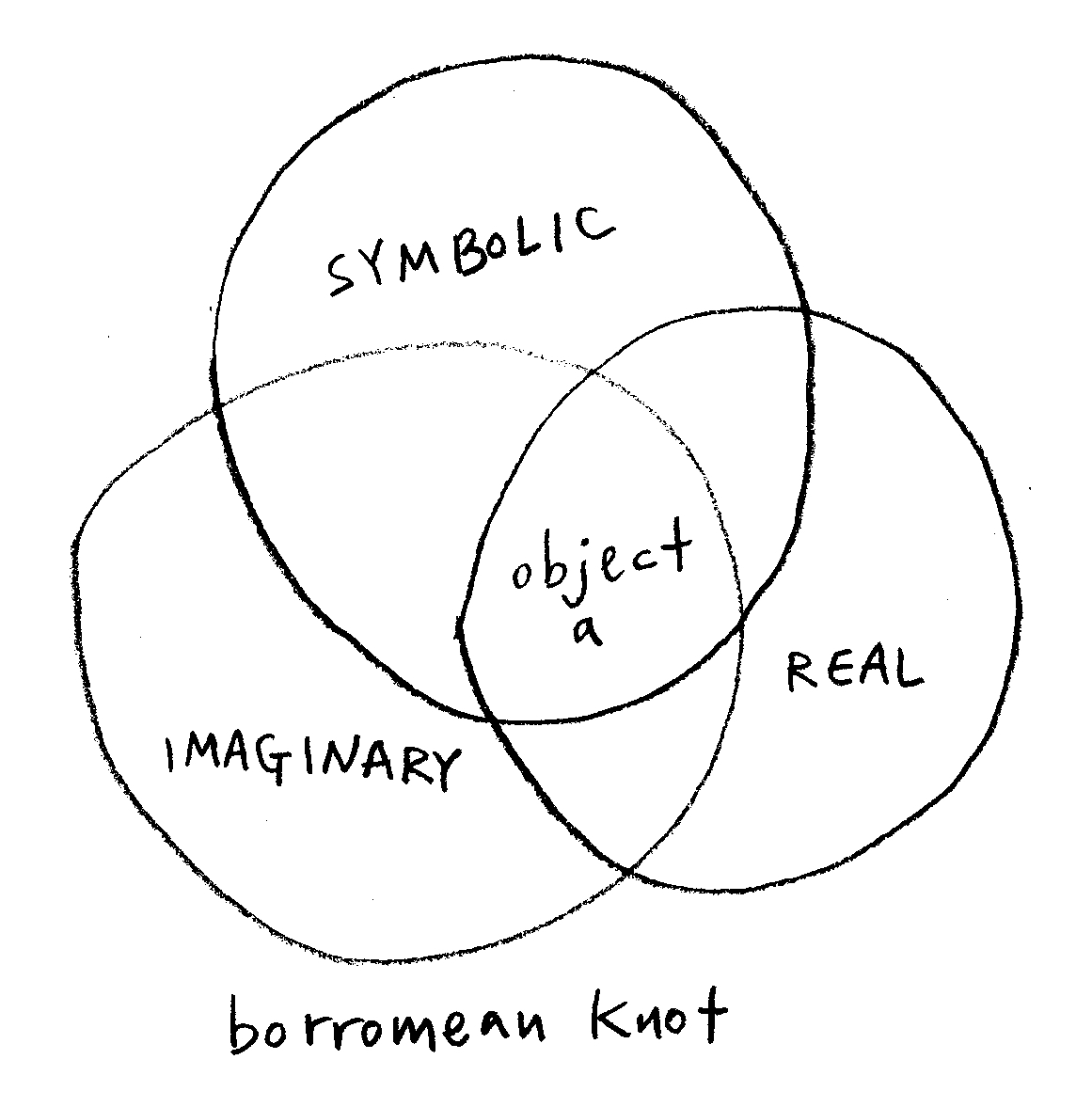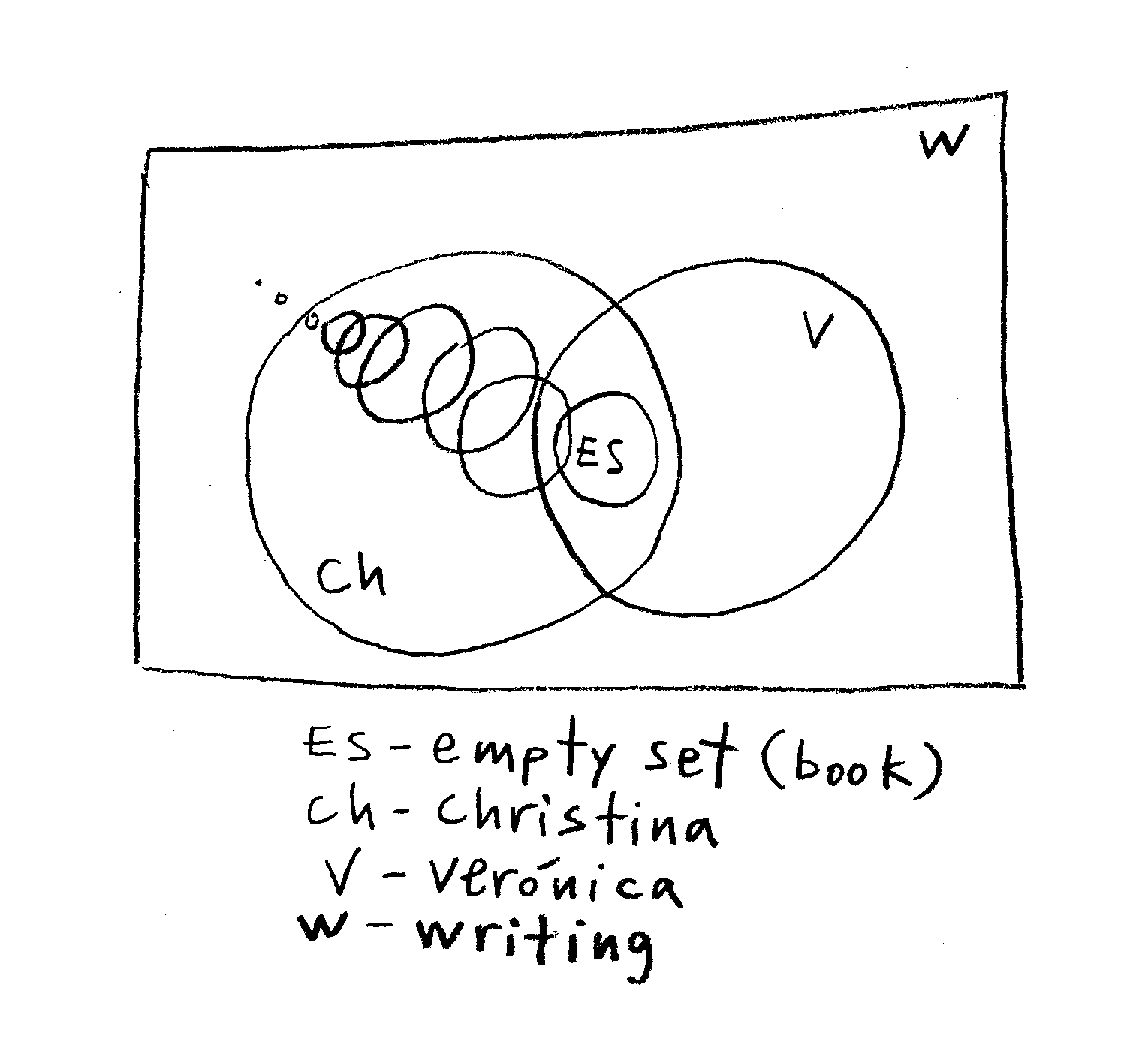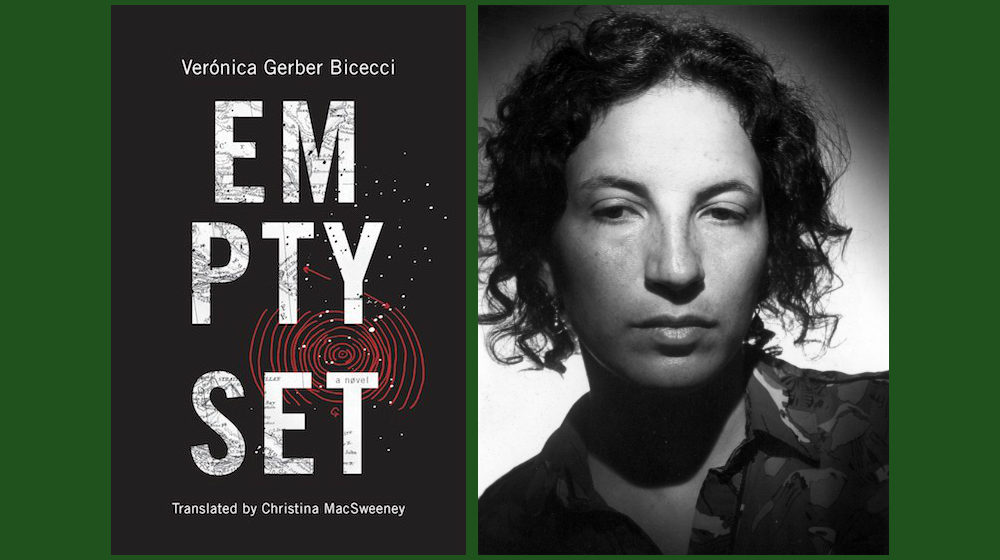When can (and when can’t) you read or write or diagram or draw your way out of a domestic “bunker” mentality? When might any such set of actions you assemble or improvise or describe or design nonetheless feel empty? When I want to ask such questions, I pose them to Verónica Gerber Bicecci. This present conversation focuses on Gerber Bicecci’s book (translated by Christina MacSweeney) Empty Set, winner of the International Aura Estrada Literature prize and the Otra Mirada Cálamo prize. Gerber Bicecci, a visual artist who writes, is also the author of Mudanza. Her most recent projects in other media include vocabulary b for MUCA Roma (Mexico City), and The Dystopian Machine for Museo de Arte Abstracto Manuel Felguérez (Zacatecas). She has been an editor at the Mexican publishing cooperative Tumbona Ediciones, and a tutor for the Photography Production Seminar (2016-2018) at Centro de la Imagen.
¤
ANDY FITCH: Could we start with Empty Set’s account (which I didn’t know if I should believe) of the 1970s Argentine military junta prohibiting the teaching of basic set theory, and with your book describing how the empty social set that dictatorship imposes (“its aim…for the most part, dispersal: separation, scattering, disunity, disappearance”) deliberately obstructs its citizens from learning “to form communities, to reflect collectively, to discover the contradictions of language”? Could we bring in Empty Set’s dedication to your real-life brother Ale, “the other half of the empty set,” and this book’s description of loneliness as a psychological state that “appears unexpectedly when we look back, there in a moment we hadn’t noticed before”? And could you start to describe how this project’s empty-set concept began to gel (to “set”) around what you or its Verónica character didn’t know (where something felt “empty”)?
VERÓNICA GERBER BICECCI:
From the start Verónica charms the reader by exuberantly declaring herself a “collector of beginnings,” of outsets, of definitively unfinished landscapes stretching “over flooded excavations, bare foundations, and ruined structures.” In fact, Verónica so incessantly makes this case for her “talent for beginnings” that by the second page she tells us: “I’m tired of preludes.” But this book certainly remains caught up in beginnings, particularly in its attachment to letters. Epistolary letters (as in: la carta) and alphabetical letters (as in: la letra) form a partially overlapping set in English translation at least — as las letras might in Spanish. So could we discuss what attracts you (and / or this Verónica character: inclined to take “the emergency exit…always at hand,” to “leap into the void when something doesn’t feel right”) specifically about the provisional, propositional, performative nature of letters of correspondence, letters initializing one’s identity, the world of letters and its literary spaces?

Alongside Verónica’s Mom (M) and Brother (B), or Tordo (T) and Tordo’s new girlfriend Her (H), or Her (H) and Her (H)’s ubiquitous twin sister (H*), or the countries Argentina (C1) and Mexico (C2), Verónica’s dad does not get his name initialized (because he plays the part of patriarchal transcendental signified?). Certain solid / stabilizing characters like Ana, and Nuar the cat, also don’t get initials. And I sensed some characters might have subtly shifted from getting initials to not necessarily needing them anymore: just as it takes a while for any character to say “Verónica” — or just as, 90% through Empty Set, the mother figure at this book’s emotional center finally gets named. Could you talk about people in the book or in life who (either for good or bad reasons) don’t get letters after their names, and / or people who only get named late in the story?

Letters (la carta and la letra) of course quickly lead to drawings and Venn diagrams here, and as Verónica’s “I” keeps ruminating on being a secondary character in her own life, on playing so many roles but never the one she really wants, I wondered if it always is the secondary character who ends up doing the diagrams. I actually pictured Dostoyevsky’s underground man undergoing drawing therapy. And as I then pictured Verónica having “nothing to do,” or musing on the assumption that “neither astronomers, nor those searching for the disappeared, nor my brother (B), nor I know anything…. We’re all trying to find traces…asking ourselves questions,” I wondered if you could discuss this protagonist / secondary character (and maybe you yourself) investigating or learning or discerning or responding or expressing (or maybe failing at all of these) by diagramming and drawing. And / or, could you describe how, in your own life, drawings by Marcel Broodthaers or Ulises Carrión or Mirtha Dermisache might have felt like they were giving you answers, or perhaps prompting this book’s axiom that “Every answer to a question is a new question,” or prompting you to pose your own questions?

Some of the meticulously delineated relations that Empty Set illustrates so well include: the relation to somebody who wishes you didn’t exist, the relation to somebody preventing your statements from becoming real, the relation to “never” (“We never lived in that house they never finished building, to which they never added a second floor…. Never, never, never”). Some of my favorite diagrams present a U / M standing for Universe and Mom (but just as well suggesting “you” and “me”), or track the operations of projective consciousness by juxtaposing Verónica’s “original Universe (U)” and her latest “parallel universe (U11)” (while suggesting an emergent cube with a two-dimensional “I” circle at its center), or enact and discuss and precisely render (for about 10 lovely pages at this book’s midpoint) the complex phenomenology of talking to a potential lover while looking at art on the walls. But one particular type of drawing I most wanted to ask about occurs, for example, when Verónica strains to depict the “slightly deformed” isosceles triangle of an unexpected encounter with Tordo and Her — in a diagram which just gets too hard to follow, and which reminds me, if anything, of Andy Warhol’s awkward dance diagrams. Similarly, the prose I most wanted to ask about happens in a weird research-based section on cones and dendrochronogy, in which references to the “first text” and the “second text” start getting mixed up, and then a “third text” arrives mysteriously, and this all culminates in the warped conclusion that: “You can even check the age of a violin or a piece of furniture by counting the number of rings in the wood.” Could you describe designing warped diagrams, and writing warped prose, and whether, when Verónica panics, or when you panic, this produces an overly complex geometry, and how it feels to try to represent that geometry after the fact?

One drawing, after the first scene with Jurgen (after Verónica says: “We were two strangers helping each other cross the street”), seemed to project outwards into a third dimension of space, and maybe a fourth dimension of time. This got me thinking about how everything happens so incrementally in Empty Set, with the mother, for instance, first starting to vanish emotionally, or with Verónica recurrently arriving at the “awful” retrospective realization that “something so obvious wasn’t,” or with certain dialogues basically offering a real-time diagram of partially overlapping, partially disconnected confusions, engagements, withdrawals, resistances to the other’s impositions, and / or unexpected communions. Or the delightfully diagramed sex scene closes on something like a sentence’s period, or a black hole, or a petite mort, with time finally stopped. And so could we return here to dendrochronology as one of this book’s pet projects, to how tree rings provide perhaps our best vantage on diagramming time? And here, if this doesn’t take us too far adrift, Empty Set seems in part a rewriting of Chris Marker’s Sans Soleil: with one of Empty Set’s most confidently stated goals (“I’d like to invent a science that investigates how a pine plywood board disorders time”) suggesting, when I first encountered it, a perfect distillation of that film, or with one page’s fused tree-ring / owlish-eyeball image making it almost impossible not to recall Sans Soleil’s obsession with one haunting scene from Vertigo, or with the brother in Empty Set designing a clandestine documentary (“He’s become obsessed with high contrast, the way an image loses definition and becomes abstract when converted into just two tones”) basically coming straight out of “the zone.”


Of course any number of diagrams likewise could sketch how Empty Set’s gradually vanishing mother figure overlaps with maternal characters in Marguerite Duras’s novels, or how the mother’s disappearance echoes Georges Perec’s La Disparition, or how a combined obsession with cones and siblings and plywood seems completely Thomas Bernhard, or how Verónica’s dusty bunker apartment could have been pulled straight from Marcel Duchamp’s Dust Breeding, or from listening to The Sundays one too many times (with “Here’s where this story ends” followed by an extra complex drawing — miraculously synthesizing so much of what came before, and also dense beyond comprehension). And of course that particular set of reference points simply suggests where my own circle might intersect with this book’s. Do any of those specific intersections seem worth discussing? And / or what other precedents seem especially important to trace?

I also definitely don’t want to overlook (with this mother a professor of psychoanalysis, specializing in Phantoms with a capital P, with Verónica early on asking “how do you hide something when you don’t know where it is?” and then soon afterwards recognizing “The things we heard came to us like that, in a disordered way, piles of disconnected anecdotes that were just pure chaos in my head,” and then soon after formulating a bit more abstractly “When an event is inexplicable, a hole is created somewhere…Holes inside holes,” and then later connecting her mother’s disappearance to Argentina’s disappeared while acknowledging the “logical absurdity,” and then later still arriving at the broader historical formulation that “Apparently, the consequences of dictatorship are felt afterwards, long afterwards”) an extensive psychoanalytic literature of intergenerational crypts and hauntings — for individuals, for families, and for whole societies struggling to emerge from silenced trauma. I associate this particular psychoanalytic focus especially with Nicolas Abraham and Mária Török. But what about you? How does your parents’ own work and thinking haunt this book?

Late into Empty Set, the grandmother herself becomes haunted by her daughter’s disappearance, and by her granddaughter’s resemblance to that daughter. So haunting seems to play out both backwards and forwards. And somehow that sensation crystallized for me especially in Empty Set’s standalone question “How do you unmake a secret?” This question seems, logically at least, so easy to answer. But of course it also suggests a whole life structured around immobilizing anxiety that can make the inquiry into or the imaginative enactment / disclosure / acknowledgment / resolution of a particularly painful secret feel so impossible. So anyway, since the grandma, like Verónica, has her own bunker, I started thinking again about bunkers — and how bunkers, like a society with a military junta, or like a human figure perceived from one’s Lacanian mirror stage, or like a single initial or name standing in for a whole complex person, can seem “from the outside…solid, impassable,” even while “Inside, it becomes increasingly unstable, unpredictable.” So, for better or worse, what are some of the bunkers in your own life? And when is reading or looking at drawings basically another form of hiding out in (and / or pushing oneself to emerge from) one’s bunker?
 Finally, I do love, also, this book’s consistent empty-set gesture of pushing sentences forward without ever establishing any grammatical subject: such as (in perhaps my favorite instance) “Must have stared at the treetops through the library window for many hours,” or for the enigmatic Marissa character’s enigmatically self-replicating / unfinished manuscript’s first sentence, “Impossible to return to the place one has left.” Empty Set’s afterword makes clear that this particular grammatical texture in the book traces one revealing overlap for how you and translator Christina MacSweeney by necessity had to collaborate on this English-language version. Could you sketch how you and Christina and Conjunto vacío and Empty Set might fit together? Or could we just take one clause (“the balls of fluff huddled together to form strange, plush baseboards in the corners”), and could you tell me what Christina translates so well here? The descriptive scene? The syntactical torque? The sound?
Finally, I do love, also, this book’s consistent empty-set gesture of pushing sentences forward without ever establishing any grammatical subject: such as (in perhaps my favorite instance) “Must have stared at the treetops through the library window for many hours,” or for the enigmatic Marissa character’s enigmatically self-replicating / unfinished manuscript’s first sentence, “Impossible to return to the place one has left.” Empty Set’s afterword makes clear that this particular grammatical texture in the book traces one revealing overlap for how you and translator Christina MacSweeney by necessity had to collaborate on this English-language version. Could you sketch how you and Christina and Conjunto vacío and Empty Set might fit together? Or could we just take one clause (“the balls of fluff huddled together to form strange, plush baseboards in the corners”), and could you tell me what Christina translates so well here? The descriptive scene? The syntactical torque? The sound?




